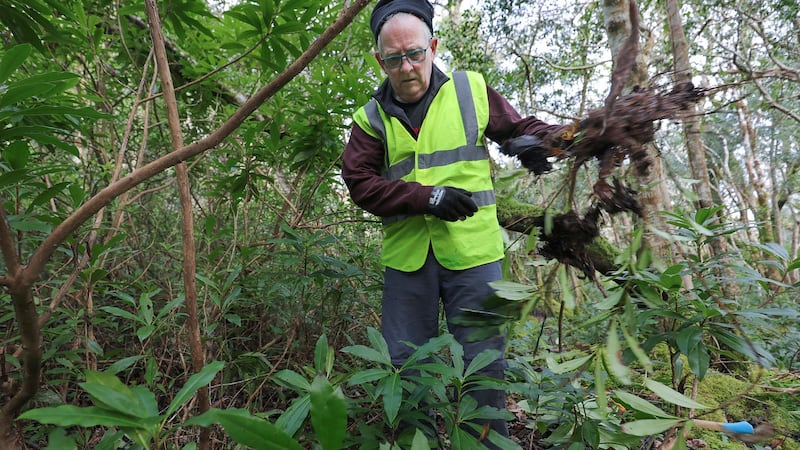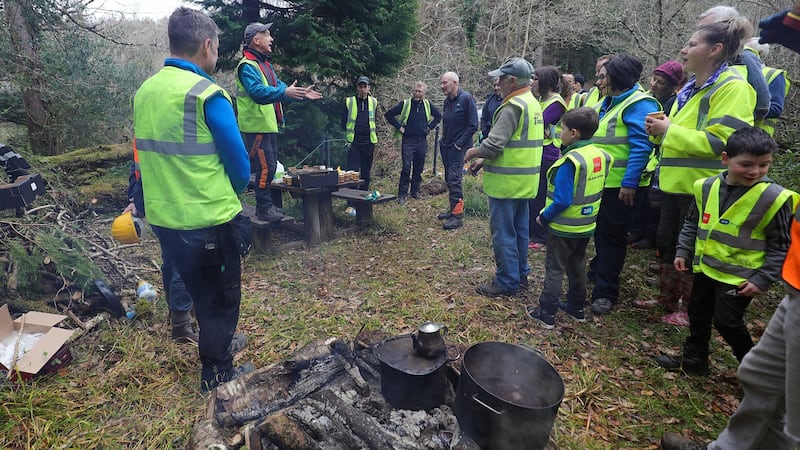Ten years ago Flor McCarthy realised he had a major problem on his farm in MacGillycuddy’s Reeks. Not only was land being taken over by rhododendron, but spring lambs let loose for the first time were nibbling the young leaves. Some were dying.
Hundreds of acres in the reeks have succumbed to the multi-stemmed shrub, which can live for 130 years and reach four metres in height in dense thickets.
“It’s becoming a massive problem. The Department [of Agriculture] don’t appreciate the scale of the problem,” says McCarthy, who manages his herd of sheep on lands spread across the Gap of Dunloe.
Rhododendron ponticum, the postcard-pretty purple-flowered plant loved by tourists, has spread widely from it now traditional 3,500 hectare base in Killarney National Park.
Today it is colonising hundreds of hectares high in the reeks, and as far south as Lauragh and west to Kells near the coast, choking out scores of native species.
Animals are also threatened, a conference in Killarney was told this month, while rescue services have been called on to locate disoriented tourists. Elsewhere, walkers in Tipperary have become lost.
The plant is no longer, as it has been for many decades, just a Kerry problem centred on Killarney. It is now threatening woodland, forest, heaths and grazing land from Galway to Mayo to Donegal, and there is no national plan for it.
It is happiest in moist and humid conditions, meaning climate change will favour its spread even further, the conference heard: “[It] will take over vast areas, hundreds of hectares,” says McCarthy, “If this is allowed to continue, you won’t have other shrubs, but you won’t have sheep either.”
Sixty hectares of his land in the Gap are being tackled by groups of workers working on a pilot programme run by the South Kerry Development Partnership. "I could not have done this myself. We must have a national project on it," he says.
Toxic to humans
Dr Therese Higgins, botanist and lecturer in the School of Science at the Munster Technological University in Tralee, agrees. The author of a guide on managing the invasive species says the plant is toxic to humans, too .
In Turkey and Wales there have been cases of "mad honey disease" – cardiac and renal problems in humans who ate the toxin-laden honey from pollen collected by unsuspecting bees from the plants' flowers. "Beekeepers must be careful," says Higgins.
Rhododendron thrives on the acidic soils of the humid western seaboard, doing less well on the drier east coast, although distribution is now widespread across the island because it is a copious seed producer. “It will grow if you let it,” she says. Up to a third of the island could support the plant.

Introduced into Killarney estates in the 1800s, followed by Sika deer from Japan, it thrived in overgrazed woodlands with the demise of the big estates when deer were no longer managed, Higgins says.
Rhododendron ponticum went from “sizeable” clumps in 1939 to being recognised as a major problem in the 1970s, while Killarney’s world-famous oakwoods are now doomed because juvenile oak plants cannot grow, while voles, beetles, birds and the Kerry slug are absent, too.
In Killarney National Park, some 2,200 of the 3,500 hectares of rhododendron is now being addressed, says Seamus Hassett, regional manager of the National Parks and Wildlife Service in the southwest, but the work is hugely labour-intensive and "is not easily done".
Data-led fightback
Foliage spraying had to be abandoned because it risked other plants, including the recently discovered mousetail fern. Each bush has to be individually treated, and park rangers are being given rock-climbing training to get at hard-to-reach plants.
The National Parks and Wildlife Service plans to map the plant’s spread throughout its Killarney lands, using handheld GPS devices that map every clump, and recording the density. Until now, the lack of data has held back the fight against rhododendron, says Hassett.
So far this year more than €500,000 has been spent tackling it in Killarney and Glengarriff, while a local volunteer group has played a significant role inside the 10,000 hectare park, laboriously making cuts into plants one at a time before spraying herbicide into the cut.

However, rhododendron is very, very hard to kill. Each stump can take three to four years before it finally dies off, while work has to continue for six to eight years afterwards to eliminate seedlings.
Noting the spread of rhododendron to MacGillycuddy's Reeks, Patricia Deane, project manager with the European Innovation Project, notes that every farmer on the reeks must join the battle to hold back the invasion.
Training in the proper use of chainsaws and chemical sprays is critical, she says. Unfortunately not every farmer has signed up. “We need everyone on board,” she says.
Mad honey disease
Honey has been used as a folk medicine since 2100 BC. However, mad honey is different from normal natural or commercially available honey, as it is contaminated with grayanotoxins, which leads to intoxication/poisoning upon consumption.
Grayanotoxin is generally found in rhododendron, and is extracted by bees from nectar and pollens of flowers. Fatalities are very rare, but eating it may still lead to arrhythmia, which can be life-threatening and hard to recognise.
Grayanotoxin acts on sodium ion channels and muscarinic receptors, leading to hypotension and different rhythm disorders including bradycardia, bradydysrhythmias, atrial fibrillation, nodal rhythm, atrioventricular blockages and respiratory depression.
Patients may also exhibit dizziness, blurred vision, diplopia (double vision), nausea, vomiting, vertigo, headache, sweating/excessive perspiration, extremity paresthesia, impaired consciousness, convulsion, hypersalivation, ataxia, inability to stand and general weakness.
It has been used as an aphrodisiac, or as an alternative therapy for gastrointestinal disorders (peptic ulcer disease, dyspepsia, and gastritis), while it has also been used to combat hypertension.
Except for a single case from Lanping County in southwest China, the prognosis for mad honey intoxication is very good, and no fatalities have been reported in modern medical literature, excluding a few in the 1800s.














